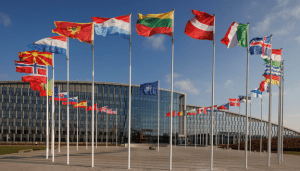TAG: GS 2: INTERNATIONAL RELATIONS
THE CONTEXT: The raising of Sweden’s national flag at NATO headquarters marks a pivotal moment, coming two years after Russia’s invasion of Ukraine.
EXPLANATION:
- The invasion, widely condemned globally, prompted Sweden, once neutral, to seek refuge under NATO’s security umbrella.
- Sweden’s accession as the 32nd NATO member is emblematic of geopolitical shifts in the aftermath of Russia’s actions.
- The strategic move adds another layer to NATO’s presence around the Baltic Sea, enhancing the alliance’s collective security guarantee.
Motivations Behind Sweden’s NATO Membership
- Impact of Russian Invasion on Public Opinion:
- The Russian invasion of Ukraine in February 2022 triggered a paradigm shift in public opinion in Sweden.
- The subsequent application for NATO membership reflected the conviction that full-fledged NATO participation was the most reasonable choice for ensuring national security.
- Nordic Solidarity and Historical Moves:
- Finland’s prior decision to join NATO in April 2023, breaking from years of military nonalignment, complemented Sweden’s move.
- The collective defense pact strengthens Nordic solidarity, responding to shared concerns about regional security.
Implications of Sweden’s NATO Membership
- Complete Baltic Sea Security Ring:
- With Sweden joining NATO, a strategic ring of alliance territory encircles the Baltic Sea.
- This geographical consolidation strengthens NATO’s position and aligns with its commitment to collective defense under Article 5.
- Steadfast Defender 24 Exercises:
- The flag-raising ceremony coincided with NATO’s Steadfast Defender 24 exercises, involving 20,000 troops from 13 countries in the high north of Sweden, Finland, and Norway.
- The scale of these exercises, NATO’s largest in decades, showcases the alliance’s readiness and determination to defend its entire territory.
Sweden’s Contributions and Expectations
- Military Capabilities and Financial Commitments:
- Sweden, with well-trained and equipped armed forces, has consistently met NATO’s defense spending target of 2% of GDP.
- The country’s commitment to sharing burdens, responsibilities, and risks aligns with NATO’s principles.
- Collaboration with NATO Amidst Russian Threat:
- Sweden’s close collaboration with NATO during military exercises, particularly in response to Russia’s invasion, positions it as a valuable ally.
- The expectation is that Sweden’s integration will enhance NATO’s capabilities in the region.
NATO:
- NATO was created by 12 countries from Europe and North America on 4 April 1949.
- Since then, 20 more countries have joined NATO through 10 rounds of enlargement (in 1952, 1955, 1982, 1999, 2004, 2009, 2017, 2020, 2023 and 2024).
- NATO’s main headquarters are located in Brussels, Belgium, while NATO’s military headquarters are in Mons, Belgium.
- Article 10 of the North Atlantic Treaty sets out how countries can join the Alliance. It states that membership is open to any “European State in a position to further the principles of this Treaty and to contribute to the security of the North Atlantic area”.
- Any decision to invite a country to join the Alliance is taken by the North Atlantic Council, NATO’s principal political decision-making body, on the basis of consensus among all Allies.
- NATO Member countries are:
- Albania, Belgium, Bulgaria, Bulgaria, Canada, Croatia, Czechia, Denmark, Estonia, Finland, France, Germany, Greece, Hungary, Iceland, Italy, Latvia, Lithuania, Luxembourg, Montenegro, Netherlands, North Macedonia, Norway, Poland, Portugal, Romania, Slovakia, Slovenia, Spain, Sweden, Türkiye, United Kingdom, United States.


